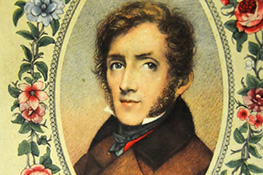Versione italiana English version Version française Versión en español
Index First editions Manzoni's collections Bibliophile's works Letters and photographs
Inside the Parenti Fund there is a large collection of works that revolve around the figure of Alessandro Manzoni. This characteristic is the result of the strong interest nurtured by Parenti for our nineteenth century and in particular for the great Lombard writer, of whom numerous editions and translations of the Promessi Sposi are present in the catalogue, together with various works of criticism and literary history that have for object his figure.
The "Rinsing of clothes in the Arno"
For centuries the question of language has given rise to a complex debate in our literary field, even with specific social characteristics. From Dante's De vulgari eloquentia to the disputes between the humanists Bembo and Trissino, from the formation of the vocabulary of Crusca to the controversies between purists and classicists in the early nineteenth century. Manzoni posed this problem by undertaking the revision of the "Promessi Sposi": he wanted to use a language that would be understood by a large audience, a living language, and set as a model the Florentine used by the educated people. To "rinse the clothes in the Arno", as Manzoni defined his undertaking, was to serve the stay in Florence in 1827. The history of this event is dedicated to the little book by Marino Parenti Manzoni, Florence and the "rinsing", published in Sarzana in 1955. This is a transcript of a lecture given by Parenti himself at Palazzo Strozzi on 22nd March 1954 for the Free Chair of Florentine Civilization. The cover depicts the houses in which Manzoni lived in Florence, next to the Ponte di Santa Trinita: the Albergo delle Quattro Nazioni and the guesthouse of Madame Hombert, in Palazzo Ferroni. The text provides an overview of the relations between Manzoni and the friends who helped him, with advice and suggestions in his work of "rinsing", and the environment that gathered around Gian Pietro Viesseux in his Literary Cabinet, and then Gino Capponi, Nicolò Tommaseo, Terenzio Mamiani, Gianbattista Nicolini and Gaetano Cioni, scientist and poet, who was particularly prodigal in his advice. Among the other characters, Emilia Luti, who Manzoni took with him to Milan as a lady-in-waiting for his daughters and to whom he dedicated a copy of the 1840 edition.
Manzoni publisher and Promessi Sposi' illustrations
After the first edition of Promessi Sposi, issued with a circulation of 2,000 official copies in 1827, Manzoni calculated that about 60,000 were finished on the market, in about forty editions, so to speak, "pirate". Copyright did not exist at the time. He then began to think of a second edition, "corrected and revised", which would actually appear, in booklets, between 1840 and 1842. This definitive version not only involved the linguistic operation consisting in the "rinsing of the cloths in the Arno", but also represented an editorial enterprise conducted in first person by the same author. Manzoni's aim, in this sense, was to protect his work from illegal copies, by printing an edition with handouts enriched with illustrations difficult to counterfeit. For the latter he finally agreed with the Turin-based Francesco Gonin, pioneer of lithography in Italy. The engravings were edited by Luigi Sacchi and the printing of the paintings was entrusted to the publishers Guglielmini and Redaelli: the volume eventually consisted of 864 pages. the circulation, very high for the epoch, was of 10.000 exemplary. But confidence in illustrations as an obstacle to the production of illegal copies was not in the end well placed, because it did not protect the work from attempts at counterfeiting. Manzoni's undertaking, which bore all the costs, ultimately resulted in a serious phonetic loss, despite the fact that in a few months more than 4,000 copies had been signed, with a very high cover price of 400 lire. The whole story of Manzoni's publishing enterprise, with a wealth of unpublished or little known documents and considerable relative correspondence, constitute the content of the volume edited by Marino Parenti under the title of Manzoni publisher. History of a famous Manzoni company, published in Bergamo by the Italian Institute of Graphic Arts in 1945.
Again, in 1961, Parenti edited a booklet that traces the history of the illustrations of the Promessi Sposi, including the famous Gonin cartoons for the fortieth, the plates of Tranquillo Crenmona and Luigi Borgomainerio for the reprint of 1869, The drawings by Gaetano Previati for the Hoepli edition of 1900 and finally the drawings by Guttuso for the Einaudi of 1960.
Manzonian bibliography
A fundamental work of Parenti as a passionate Manzionian scholar is the Manzoni Bibliography in three volumes, published by Sansoni in 1936 with a preface by Giovanni Gentile. This work, the result of the systematic examination of bibliographical works and catalogues of libraries, and for the most recent editions of the references of the same publishers, had in 70 years more than 150 editions. In the first volume we find the cataloguing of the general collections and the editions of the Promesssi Sposi, in the second the partial collections and the separate editions of the single works, translations, fragments and parodies, Finally, the third volume contains writings on the life and works of Manzoni and an analytical index. The monumental Bibliography earned Parenti the official investiture of his preface, Gentile, who entrusted him with the direction of the International Centre of Manzonian studies, in Milan, then run by Parenti until 1945.
Manzonian images
Marino Parenti also collected and illustrated the images of the life and times of Alessandro Manzoni, a work published by Hoepli in 1942, divided into several chapters: The family, Life, Portraits, Other testimonies of life (from Manzoni's participation in the Literary Academies to the hail policies...) and finally the Fortuna del Manzoni (on the diffusion and translation of his works).

